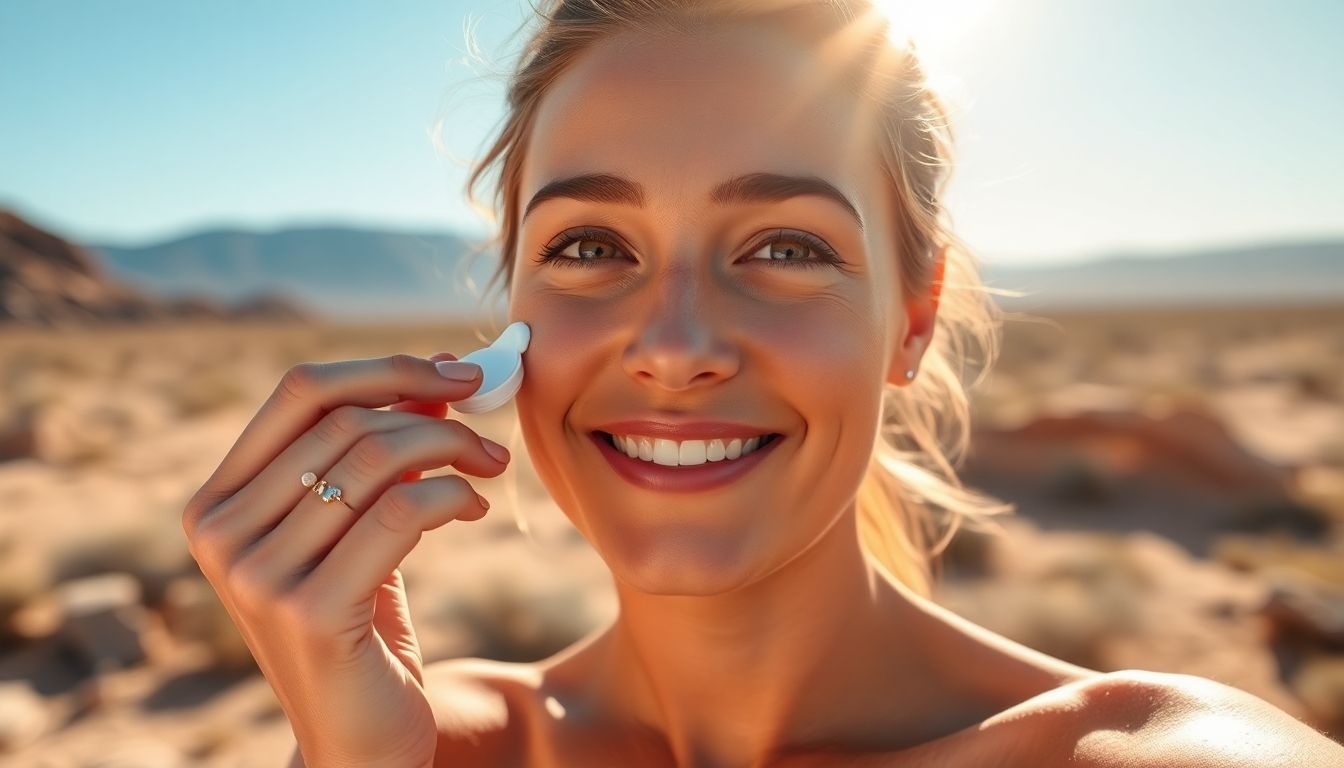
Living in a desert climate means your skin faces some tough challenges. We’re talking super dry air, intense sun, and big temperature swings. All these things can really mess with your skin, making it dry, irritated, and even prone to early aging. But don’t worry! With the right skincare routine for desert climate, you can keep your skin happy and healthy. This guide will walk you through everything you need to know to protect your skin and keep it looking great, no matter how harsh the desert gets.
Key Takeaways
- Desert air is really dry, so your skin loses moisture fast. You need to use super hydrating products to keep it from drying out.
- The sun in the desert is no joke. Always use a strong sunscreen and wear hats or other protective clothing to shield your skin.
- Your skin’s protective barrier can get damaged in the desert. Use gentle cleansers and products that help repair this barrier.
- Don’t forget about your lips and hands; they get really dry in the desert too, so make sure to give them extra care.
- Drinking enough water is just as important as what you put on your skin. Hydration from the inside out really helps.
Understanding Desert Climate’s Impact on Skin
Low Humidity Challenges
Desert air is super dry, like, almost zero humidity sometimes. This means your skin is constantly losing water to the environment. Think of it like a sponge left out in the sun – it dries up fast. This can lead to:
- Flaky skin that just won’t quit.
- That tight, uncomfortable feeling.
- Even cracks in your skin if you don’t hydrate properly.
Intense Sun Exposure
Deserts get a ton of sun. Clear skies and minimal shade mean high levels of UV radiation. And we all know what that means:
- Sunburns, obviously.
- Premature aging (think wrinkles and sunspots).
- Long-term skin damage that can be serious.
Temperature Extremes
Desert temperatures can swing wildly between day and night. One minute you’re sweating, the next you’re shivering. These rapid changes can really mess with your skin. It’s like your skin doesn’t know what to do! This can lead to:
- Weakened skin barrier.
- Increased sensitivity.
- Inflammation and redness.
Living in the desert, I’ve learned that my skin needs constant attention. It’s not just about slapping on some lotion and hoping for the best. You really have to understand what the climate is doing to your skin to keep it healthy.
The Pillars of Desert-Proof Skincare
To really take care of your skin in a desert environment, you can’t just do the bare minimum. You need a solid plan. These are the main things to focus on:
Superior Hydration
Desert air is super dry, so your skin needs all the moisture it can get. Forget those light lotions; you need the heavy stuff. Look for ingredients that pull water into your skin, like hyaluronic acid, and things that trap the moisture, like shea butter. I’ve found that putting products on when my skin is still a little damp helps a lot. And don’t forget to drink tons of water!
Robust Sun Protection
Seriously, the sun here is no joke. Sunscreen every single day is a must. I’m talking SPF 30 or higher, and you have to put it on again every couple of hours, especially if you’re outside. Mineral sunscreens with zinc oxide are usually better if you have sensitive skin. Also, hats and sunglasses are your friends. Don’t leave home without them. You can also look into UPF-rated clothing for extra protection.
Gentle Cleansing
It’s a tricky balance. You need to get rid of dirt and sweat, but you don’t want to strip all the natural oils from your skin. I like using non-foaming cleansers that don’t have sulfates. Those can be really drying. If you wear makeup, try double cleansing – start with a cleansing balm or oil, then use a gentle cleanser. Harsh scrubs are a big no-no.
Barrier Repair and Reinforcement
Think of your skin barrier as your bodyguard. It keeps the bad stuff out and the good stuff in. To keep it strong, use products with ceramides and niacinamide. These help fix damage and keep moisture from escaping. Don’t go overboard with exfoliating or using too many strong products, because that can mess up your barrier. When your skin feels good, that’s how you know your barrier is doing its job.
Living in the desert, I’ve learned that skincare isn’t just about looking good; it’s about protecting your skin from some pretty harsh conditions. It’s about finding the right balance of hydration, protection, and gentle care to keep your skin healthy and happy.
Your Desert Skincare Routine: Step-by-Step
Crafting a skincare routine for a dry climate is all about picking the right products and using them in the correct order. Let’s break down how to structure your desert skincare routine, from morning to night, with a few weekly treatments thrown in for good measure.
Morning Routine
Desert mornings often mean low humidity and intense sun. Your skin needs gentle care and strong protection to get through the day. Here’s what I do:
- Gentle cleanse (optional): If my skin isn’t too oily when I wake up, I just splash some lukewarm water on my face. Over-cleansing can strip away important oils, especially in a dry place. If you need a cleanser, go for something mild and hydrating without sulfates.
- Hydrating serum (Hyaluronic Acid): I put on a hyaluronic acid serum while my skin is still a little damp. This stuff is amazing because it pulls moisture into your skin. It’s a must-have for arid climate skincare.
- Rich moisturizer: Next, I use a moisturizer that’s thick and contains things like ceramides, squalane, or shea butter. These help lock in moisture and protect your skin from the environment.
- Broad-spectrum SPF 50+: Sunscreen is a must in the desert. I use a broad-spectrum sunscreen with SPF 50 or higher. If I’m going to be sweating or outside a lot, I make sure it’s water-resistant.
- Lip balm with SPF: Don’t forget your lips! They get dry and sunburned easily. I use a lip balm with SPF to keep them protected.
I’ve found that consistency is key. Even if I’m rushing, I try to stick to these steps. It really makes a difference in how my skin feels throughout the day.
Evening Routine
After a day in the desert, your skin needs some serious TLC. Here’s my evening routine:
- Double cleanse: First, I use a cleansing oil or balm to remove makeup, sunscreen, and any dirt. Then, I follow up with a gentle cleanser to make sure my skin is really clean.
- Hydrating toner: I use a hydrating toner to balance my skin’s pH and add another layer of moisture.
- Treatment serum (Retinol or Peptides): A few times a week, I’ll use a treatment serum like retinol or peptides to help with anti-aging or skin repair. I don’t use them every night because they can be a bit harsh.
- Rich moisturizer: Just like in the morning, I use a thick moisturizer to hydrate my skin overnight.
- Facial oil (optional, for extra nourishment): If my skin feels really dry, I’ll add a few drops of a facial oil like rosehip or marula oil after my moisturizer. It helps seal in the moisture and makes my skin feel extra soft.
- Lip mask or thick lip balm: I put on a thick lip treatment to keep my lips from drying out overnight.
Weekly Treatments
Weekly treatments are important for keeping your skin healthy without overdoing it. Here are a few things I do:
- Hydrating sheet masks: These give my skin a big boost of moisture and help soothe any dryness. I try to use one at least once a week.
- Gentle, non-abrasive exfoliants (if necessary, very sparingly): I use a mild exfoliant like lactic acid or an enzyme-based product maybe once a week. Over-exfoliating can really damage your skin, especially in the desert.
- Overnight masks: I use a nourishing overnight mask once or twice a week to deeply hydrate and repair my skin while I sleep. It helps my skin handle the desert elements better.
| Treatment | Frequency | Benefits |
|---|---|---|
| Sheet Mask | 1x/week | Intense hydration, soothes dryness |
| Gentle Exfoliant | 1x/week | Removes dead skin cells, improves texture (use sparingly) |
| Overnight Mask | 1-2x/week | Deep hydration, repairs skin, enhances resilience against harsh conditions |
Essential Desert Skincare Products and Tools
When it comes to surviving the desert climate, having the right skincare arsenal is a game-changer. It’s not just about slapping on any old cream; it’s about choosing products designed to combat dryness, sun damage, and all the other lovely things the desert throws at your skin. Let’s break down the must-haves:
Sunscreen Selection
Sunscreen isn’t just for the beach when you’re in the desert; it’s your daily armor. Look for a broad-spectrum sunscreen with an SPF of 30 or higher. Mineral sunscreens, containing zinc oxide or titanium dioxide, are often a good bet, especially if you have sensitive skin. They create a physical barrier against the sun’s rays, which some people find less irritating than chemical sunscreens. Don’t forget to reapply every two hours, especially if you’re spending time outdoors.
Moisturizer Choices
In the desert, your moisturizer needs to be a heavy hitter. Lightweight lotions might feel nice initially, but they often evaporate quickly, leaving your skin feeling just as parched as before. Instead, opt for richer creams and balms that contain ingredients like hyaluronic acid, ceramides, and shea butter. Hyaluronic acid is a humectant, meaning it draws moisture from the air into your skin. Ceramides help to repair and strengthen your skin barrier, preventing moisture loss. Shea butter is an emollient that softens and smooths the skin.
Hydrating Serums and Oils
Serums and oils can give your skin an extra boost of hydration. Look for serums containing hyaluronic acid, niacinamide, or vitamin E. These ingredients can help to hydrate, soothe, and protect your skin. Facial oils, like jojoba, rosehip, or argan oil, can also be beneficial, especially if you have very dry skin. They help to seal in moisture and provide additional nourishment.
Targeted Lip Care
Your lips are often the first to suffer in the desert climate. They’re constantly exposed to the elements and lack the oil glands that keep the rest of your skin hydrated. That’s why it’s important to give them some extra TLC. Look for lip balms containing ingredients like beeswax, shea butter, or coconut oil. And, just like with your sunscreen, make sure your lip balm has an SPF of 30 or higher. Reapply frequently throughout the day, especially after eating or drinking. For an extra boost of hydration, consider using a lip mask at night. This can help to deeply moisturize your lips and prevent them from cracking or chapping. Don’t forget to protect your skin barrier with the right products.
Living in the desert, I’ve learned that skincare isn’t a luxury; it’s a necessity. The right products can make all the difference in keeping your skin healthy, hydrated, and protected from the harsh elements. It’s all about finding what works best for you and sticking with it.
Common Skincare Mistakes to Avoid in the Desert
It’s easy to make skincare mistakes anywhere, but the desert environment really amplifies the consequences. Avoiding these common pitfalls can make a huge difference in how your skin feels and looks. It’s all about understanding the unique challenges and adjusting your habits accordingly.
Using Harsh Cleansers
This is a big one. Those super-foaming cleansers might feel like they’re really cleaning, but in the desert, they’re likely stripping your skin of essential oils. This leads to increased dryness and irritation. Think about it – your skin is already fighting a losing battle against the dry air. Why make it harder? Instead, switch to something gentle, like a cream or oil-based cleanser. Your skin will thank you.
Neglecting Lips and Hands
It’s so easy to focus on your face and forget about your lips and hands, but they’re just as exposed to the elements. Lips can get incredibly chapped and even sunburned, and hands can become dry, cracked, and painful. Keep a good lip balm with SPF handy and reapply it often. The same goes for hand cream. Make it a habit to apply both several times a day, especially after washing your hands. I keep one in my car, one at my desk, and one by my bed so I always have lip protection available.
Underestimating Indoor Dryness
You might think you’re safe inside, but air conditioning and heating can be just as drying as the desert air. In fact, sometimes they’re even worse! Don’t assume that just because you’re not outside, you don’t need to hydrate and protect your skin. Keep up with your routine, even indoors. Consider using a humidifier, especially in your bedroom, to add some moisture back into the air.
Not Drinking Enough Water
This seems obvious, but it’s worth repeating. Hydration starts from the inside out. No amount of moisturizer can compensate for not drinking enough water. Aim for at least eight glasses a day, and even more if you’re active or spending time outdoors. Dehydration exacerbates skin dryness and makes it harder for your skin to recover from environmental stress. It’s a simple step, but it makes a huge difference.
It’s easy to fall into these traps, especially when you’re first adjusting to a desert climate. But with a little awareness and some simple changes to your routine, you can keep your skin healthy and happy, even in the driest conditions. Remember, consistency is key!
Advanced Strategies for Desert Skincare
Layering Hydration Effectively
Okay, so you’re already moisturizing, but is it enough? In the desert, probably not. It’s all about layering. Think of it like building a hydration fortress. Start with the lightest products and work your way up to the heaviest.
- Start with a hydrating toner or essence: These are super lightweight and prep your skin.
- Follow with a hyaluronic acid serum: This stuff pulls moisture from the air (or your damp skin) into your skin.
- Apply a lightweight moisturizer: This adds another layer of hydration.
- Seal it all in with a richer cream or balm: This prevents moisture from escaping.
Don’t forget to apply your products to slightly damp skin. This helps them absorb better and locks in even more moisture. It’s a game changer, trust me.
Repairing Sun Exposure Damage
Let’s be real, even with sunscreen, you’re probably getting some sun damage. It’s just part of desert life. So, what can you do? Focus on ingredients that help repair and protect.
- Vitamin C serum: This is a powerhouse antioxidant that helps brighten skin and protect against further damage.
- Retinoids (like retinol or tretinoin): These help with cell turnover and can reduce the appearance of sunspots and wrinkles. But, be careful, they can be drying, so start slow and use them at night.
- Niacinamide: This helps calm inflammation and improve skin barrier function, which is crucial for repairing sun damage.
Sealing in Intensive Moisture
Sometimes, your skin just needs a little extra TLC. That’s where occlusives come in. These create a barrier on your skin that prevents water loss. Think of them as the final step in your hydration routine.
- Facial oils: Jojoba, rosehip, and argan oil are all great options. Apply a few drops after your moisturizer.
- Balms: These are thicker than oils and provide intense moisture. Look for ingredients like shea butter or beeswax.
- Sleeping masks: These are designed to be worn overnight and provide a boost of hydration while you sleep. They’re like a supercharged moisturizer.
| Product Type | Key Ingredients | Benefits |
|---|---|---|
| Facial Oils | Jojoba, Rosehip, Argan | Seals in moisture, adds nourishment |
| Balms | Shea Butter, Beeswax | Intense moisture, protects skin barrier |
| Sleeping Masks | Hyaluronic Acid, Ceramides | Deep hydration, repairs skin overnight |
The key is to find what works best for your skin and to be consistent with your routine. Don’t be afraid to experiment and adjust as needed. Your skin will thank you!
Maintaining Skin Health in Arid Environments
Adapting to Seasonal Changes
Desert climates aren’t static; they shift with the seasons, and your skincare should too. What works in the scorching summer might not cut it in the cooler, drier winter. The key is to observe your skin and adjust accordingly. For example, you might need a richer moisturizer in the winter months when humidity plummets even further. In the summer, you might want to switch to a lighter, gel-based formula to avoid feeling greasy. Don’t be afraid to experiment and find what works best for you during each season.
Personalizing Your Routine
What works for your neighbor might not work for you. Everyone’s skin is different, and factors like age, skin type, and specific concerns (like acne or eczema) all play a role in determining the ideal skincare routine. Pay attention to how your skin reacts to different products and ingredients. Keep a journal if it helps! If something causes irritation or breakouts, ditch it. If something makes your skin feel amazing, stick with it. It’s all about finding what works for your unique skin.
- Consider your skin type: oily, dry, combination, or sensitive.
- Address specific concerns: acne, aging, hyperpigmentation.
- Patch-test new products before applying them to your entire face.
Seeking Professional Guidance
Sometimes, despite our best efforts, our skin just isn’t cooperating. That’s when it’s time to call in the experts. A dermatologist or licensed esthetician can provide personalized advice and treatments tailored to your specific needs. They can also help you identify any underlying skin conditions that might be contributing to your problems. Don’t hesitate to seek professional help if you’re struggling to manage your skin on your own. They can offer a level of expertise that you just can’t get from reading articles online.
It’s easy to get overwhelmed by the sheer amount of skincare information out there. A professional can cut through the noise and provide clear, actionable advice that’s specific to your skin. They can also recommend products and treatments that are backed by science and proven to be effective. Think of it as an investment in your long-term skin health.
Wrapping Things Up: Your Desert Skin Journey
So, there you have it. Taking care of your skin in the desert isn’t just about slapping on some lotion; it’s a whole different ballgame. You’ve got to really think about hydration, protecting yourself from the sun, and keeping that skin barrier strong. It’s easy to mess up, like forgetting your sunscreen or scrubbing your face too hard, but if you stick to the plan we talked about, your skin will thank you. Remember, it’s all about giving your skin what it needs to stay happy and healthy, even when the desert tries its best to dry it out. You can totally have great skin here, it just takes a little extra effort and the right stuff.
Frequently Asked Questions
Do I still need to use special skincare products if I spend most of my time indoors in a desert climate?
Yes, absolutely! Even indoors, air conditioning and heating can make the air very dry, pulling moisture from your skin. It’s important to keep using your hydrating products and moisturizers, and consider a humidifier to add moisture back into the air.
What SPF level should I use in the desert, and how often should I put it on?
You should use a sunscreen with at least SPF 30 every single day, even on cloudy days. In the desert, where the sun is very strong, SPF 50 or higher is even better. Make sure it says ‘broad-spectrum’ to protect against both UVA and UVB rays.
What are the best ingredients to look for in moisturizers and serums for desert skin?
Look for ingredients like hyaluronic acid, glycerin, ceramides, squalane, and shea butter. These are great for drawing moisture into your skin and then locking it in, which is super important in dry desert air.
What common skincare mistakes should I avoid when living in a desert climate?
It’s best to avoid harsh cleansers that foam a lot or contain sulfates, as these can strip your skin’s natural oils and make it even drier. Also, be careful with strong exfoliants or too many active ingredients, as they can damage your skin’s protective barrier.
How important is drinking water for my skin in a desert environment?
Drinking enough water is super important because hydration starts from the inside. When you’re dehydrated, your skin can’t hold onto moisture as well, making it feel dry and tight. So, yes, drink plenty of water throughout the day!
Why are my lips and hands so dry in the desert, and what can I do about it?
Your lips and hands are often exposed to the sun and dry air, making them very prone to dryness, cracking, and sun damage. Always use a lip balm with SPF, and keep your hands moisturized, especially after washing them.






